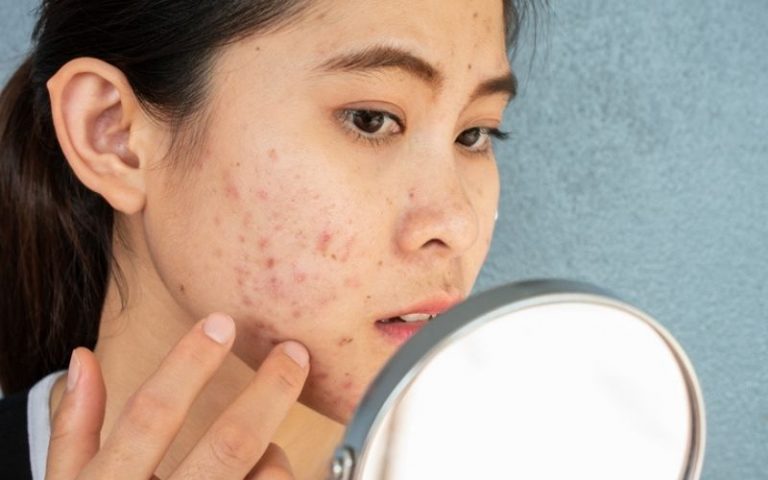The Beginner’s Guide To Identify Skin Type

Understanding your unique skin type and how it responds to different situations or seasons is the most significant step in taking care of your skin. If you don’t take good care of your skin, no amount of cosmetics will be able to give you the appearance you want.
Knowing your skin is the keystone to caring for it since knowledge enables you to select the best products for you and address potential issues without creating new ones. The sooner you begin, the better your skin quality will be as you age.
Discovering your skin type is the first and most crucial step in skin care. By taking the time to understand your skin’s unique requirements, you’ll be better able to make the choices that will balance your skin and give you a healthier, more beautiful complexion.
Why Is It Important To Know Your Skin Type?
Understanding your skin type will help you to care for your skin better. You can make informed decisions while purchasing skincare products and customize care and protection for your skin in the long run.
Using the wrong cosmetics on your skin may aggravate and send wrong signals like underproduction or overproduction of oils that could lead to drier skin or excessive oiliness, acne, and other breakouts.
Knowing your skin type may save you in situations including dealing with acne, sun damage, or skin ailments. You may also be able to pick almost the right products for you, such as sunscreen, foundation, cleanser, lipstick, etc.
The skincare regimen that works for others may not necessarily work for you. Everyone’s skin is unique, and you may receive more adverse reactions to your skin than others.
Hence, it is crucial to identify your skin type before building a routine skincare regime.
Characteristics of Each Skin Types
Seven skin types – normal, oily, combination, dry, sensitive, acne-prone, and mature – each has its benefits and challenges.
The optimal formulas for each skin type might differ greatly, even though everyone requires the basic items (including cleanser, moisturizer, and SPF). Therefore, the key to creating a routine that works for you is understanding where your skin falls on the skin type spectrum.
Here’s a brief overview of each skin type:
- Normal Skin
A person’s skin is usually well-balanced, i.e., not too dry or too oily. This skin is not prone to flakiness, breakouts, or feeling greasy or tight. Normal skin typically has a smooth skin texture and tiny pores and is less prone to sensitivity or blemishes.
Normal skin has no specific issues or concerns. Still, it requires appropriate care to maintain its protective barrier, smooth skin texture, and glowy appearance.
Features:
- No or few flaws
- No sensitivity
- Hardly visible pores
- Glowing complexion
- Good blood circulation
- Uniform transparency
- Soft and smooth texture
Skin Care Tips:
Suppose you have normal skin; lucky you! Your skin may be able to tolerate most ingredients and have tons of options with beauty products. But still use a gentle, effective cleanser, a non-irritating AHA or BHA exfoliant, sunscreen, and a well-formulated moisturizer with skin-restoring and skin-soothing agents.
- Dry Skin
Dry skin naturally produces fewer natural oils than other types of skin. This skin type cannot retain moisture, which impairs barrier function. It may look dull and become flaky, scaly, or rough. The skin often feels less elastic or tight with more visible fine lines. In addition, it may become itchy or aggravated.
Features:
- Rough and blotchy appearance
- Low skin elasticity
- Itchiness
- Scaling
- Roughness
- Dull, rough complexion
- More visible lines
Skin Care Tips:
Applying a heavy moisturizer multiple times per day, especially after bathing or washing your hands, is the best way to care for dry skin. Try to maintain warm, humid air in your home to aid healing. Avoid using harsh soaps or those with a lot of fragrance or citrus oils.
Conversely, if your skin is dehydrated, opt for water-based products because oil-based ones may exacerbate your skin’s condition. The most crucial thing is ensuring you have enough water each day.
- Oily Skin
Oily skin types have an overproduction of sebum. The face is always oily, creating a persistently shiny or greasy appearance. This skin type is prone to clogged and enlarged pores, comedones with the accumulation of dead skin cells.
Generally, makeup or skincare products don’t always stay on oily skin.
Features:
- Enlarged pores
- Dull or glossy, thick complexion
- Pale, thicker skin
- Pimples, blackheads, and other blemishes
Skin Care Tips:
Shine control is crucial for people with oily skin. You should avoid chemicals like mineral oil, petrolatum, and alcohol, even if having oily skin has advantages. For oily skin, “non-comedogenic” products are ideal because they won’t clog your pores.
You still need to moisturize, so your greatest buddies are oil-free moisturizers, chemical exfoliants, and clay masks. Don’t overwash your face because doing so will dry out your pores and force them to bring forth more oil to make up for it.
- Combination Skin
The unique character of combination skin includes dry and oily areas on the face. Here, the T-zone appears oily, and the cheeks will be either dry or normal. This skin type can vary due to stress, weather, or hormone fluctuation.
Features:
- Oily T-zone
- Enlarged pores, more prominent than others
- Blackheads
- Shiny skin
- Normal to dry cheeks
Skin Care Tips:
The combination skin may appear dry and itchy in the winter and oily and glossy in the summer. Hence, a customized skin care regimen is the key to managing combination skin types.
- Sensitive Skin
The primary cause of sensitive skin is genetics, allergies, or environmental factors. It reacts more to stimuli to which normal skin does not respond. This fragile skin is usually accompanied by feelings of discomfort, like tightness, heat, redness, or itching.
Features:
- Skin that flushes easily
- Recurring rashes and bumps
- Burning or stinging after application of skincare products
- Adverse reactions to chemical fragrance
- Patches of dry, flaky, irritated skin
Skin Care Tips:
Be more aware while choosing cosmetics, as you’re more prone to redness, irritation, stinging, burning, and acne breakouts. Stay away from chemical fragrances and irritants like alcohol or antibacterial ingredients. Look for products with calming, healing, and anti-inflammatory properties.
- Acne-Prone Skin
Frequent breakouts are the primary characteristic of acne-prone skin. Your pores tend to clog easily, making you more susceptible to blackheads, whiteheads, or pimples than other skin types.
Features:
- Whiteheads (closed plugged pores)
- Blackheads (open clogged pores)
- Pimples with pus at their tips
- Small red, tender bumps (papules)
- Large, painful, solid lumps under the skin
- Pus-filled lumps under the skin with pain (cystic lesions)
Skin Care Tips:
Use cleansers to treat acne, exfoliants, and moisturizers to help minimize breakouts. You can also use topical gel to treat and lighten acne scarring. Look for products with acne-fighting ingredients like salicylic acid, clay, benzoyl peroxide, or retinol.
- Mature Skin
Even though not everyone’s skin ages at the same rate, the symptoms are very common. You could start to notice a few wrinkles or more dryness than you had when you were younger. You might see sagging, dark patches, dullness, and dehydration in the skin that is more mature.
Features:
- Dullness
- Dry and pale skin
- Open pores
- Hyperpigmentation
- Sagging
- Noticeable wrinkles due to thinner or drier skin
Skin Care Tips:
Mature skin needs more intensive skin care. It is not too late to start a regimen of restorative therapies, which can increase collagen and offer protection from cell aging and environmental irritants.
How To Figure Out Your Skin Type?
Skin condition, as opposed to skin type, can change significantly throughout your life. Numerous internal and external factors affect your skin’s condition, including pollution, weather, medications, stress, hereditary factors, products used, and skincare decisions.
You should choose skincare products based on skin type and condition. Dermatologists and other skincare specialists measure the following criteria to establish a person’s skin type:
- See how your skin feels
It’s important to feel your skin on any given day. Your skin texture can reveal its essential nature.
- In combination skin, you may notice oily in the T-zone (the area includes your forehead, nose, and chin) and dryness everywhere else.
- You may feel itchy, patchy, dry, and sting if your skin type is sensitive.
- Normal skin always shows an even and balanced structure without dryness and oiliness.
- The greasy, glossy, and shiny feel of your face throughout the day indicates oily skin.
- A tight and dry feel and the flaky cracks in the winter months denote dry skin.
- Examine your pores
Your pores can be good indicators. Their size and clogging tendency can help you understand more about your skin and its oil production.
- Combination skin may have large clogged pores around the nose and unnoticeable pores on the cheeks and other areas of the face.
- Sensitive skin has regular to large pores, but its size may vary based on your skincare products.
- Ordinary skin people have unnoticeable pores.
- Pores on oily skin often get easily clogged with sweat and oils the body secretes.
- Dry skin possesses tiny and tight pores.
- Check your skin after cleansing
A cleanser may react differently to different skin types.
- Combination skin feels clean, refreshed, and oil-free around the nose portion and tight and dry around the cheeks after cleansing.
- Sensitive skin feels clean and a bit dry after cleansing. But sometimes, it may trigger itching and irritation.
- Normal skin will be clean and clear after cleansing. It doesn’t feel too dehydrated or sensitive.
- Oily skin feels clean and oil-free for a few minutes after cleansing. But the oil may return shortly.
- Dry skin feels more dehydrated after cleansing.
- See how often you need a moisturizer
Everyone needs a moisturizer to keep the skin healthy and hydrated. How often you use a moisturizer indicates your skin’s capacity to stay hydrated and your skin type.
- In combination skin, some areas on the face will frequently dry out (often the cheeks) and will frequently need the addition of moisturizers.
- Sensitive skin needs a moisturizer only less frequently. But picking the best moisturizer that doesn’t irritate sensitive skin is tedious.
- Normal skin does not need a moisturizer very often throughout the day, as the skin stays moisturized on its own.
- Moisturizer tends to make oily skin even oilier. So better avoid moisturizing very often throughout the day.
- Dry skin requires more moisturization throughout the day.
How Can You Tell If Your Skin Is Dry or Oil?
We can identify dry and oily skin types by doing a few easy tests. The blotting sheet method is a quick and effective way to differentiate oily and dry skin types. If you are lazy, you can try the faster and easier method – Blotting Sheet.
The Blotting Sheet Method
- Take some good-quality blotting paper in your hand and gently pat it on different parts of your face.
- Do not swipe.
- Now, hold the blotting sheet up to the light.
Results:
- Dry Skin: You may have a dry skin type if you can see no oil on it.
- Oily Skin: Your skin type is oily if the paper contains more oil.
- Combination Skin: In the case of combination skin type, you can see oil from your nose, forehead, and chin only.
- Normal Skin: If the paper has only fewer traces of oil, then you have a normal skin type.
- Sensitive Skin: If you feel a little itchy or red, you are most likely to have sensitive skin.
The Bare-faced Method
This method is yet another simple way to figure out your skin type in the comfort of your home:
- First, cleanse your face thoroughly with a mild cleanser and gently pat dry.
- Leave the skin bare (don’t use moisturizers, serums, or other stuff).
- After about 30 minutes, look at your cheeks, chin, nose, and forehead for any shine.
- After another 30 minutes, check whether your skin feels parched, especially if you smile or make other facial expressions.
- If your skin feels taut, your skin is likely to dry.
- If you note the shine on your nose and forehead, your skin is mostly combinational.
- It is most likely oily skin if shine is on your cheeks, forehead, and nose.
The Takeaway
For our skin to function and look its best, it is crucial to take the appropriate steps to understand its needs. Our skin’s needs can alter over time. Your skin will remain balanced and lovely as long as you are mindful of its health and regularly check in to see whether any modifications to your existing regimen are required.
References
Characteristics of Each Skin Type
https://www.dermstore.com/blog/what-is-my-skin-type/
https://www.cerave.com/skin-smarts/skincare-tips-advice/what-skin-type-do-i-have
https://www.webmd.com/beauty/whats-your-skin-type#091e9c5e80566596-1-6
https://int.eucerin.com/about-skin/basic-skin-knowledge/skin-types
How To Figure Out Your Skin Type In Simple, Easy Steps
https://www.skinvision.com/articles/how-to-determine-your-skin-type-in-four-easy-steps/
How Can You Tell If Your Skin Is Dry or Oil?
https://www.myglamm.com/glammstudio/how-to-determine-your-skin-type
https://www.tatcha.com/blog/How-to-determine-your-skin-type.html
Simple Home Methods for Determining Your Skin Type
https://www.tatcha.com/blog/How-to-determine-your-skin-type.html





